Cobs and the Maritime Silk Road: a Survey of Cobs found in Yemen
by Kyle Ponterio
The Spanish Piece of Eight was the first universal currency used on a global scale for centuries. Recognized for being of good purity metal, consistent in weight, obtainable in quantity and in easily identifiable designs it perfectly suited the Spanish gold and silver of the mainland and her colonies to be utilized in domestic and international commerce. The far reaching implications of the specie produced from these Spanish mints can be seen the world over, from the Galleon trade to the Silk Road trade routes. In Yemen, a varied group consisting of Philip II and Philip III cobs from Spanish and Spanish colonial mints has been discovered and cataloged. The Spanish Piece of Eight and its various iterations saw extensive use and circulation dispersing to the farthest reaches of the globe. In times of need the Piece of Eight was destined to be imitated.
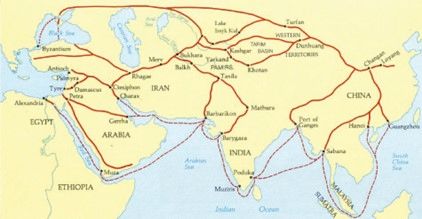
Clearly trade routes worked both ways. Goods, specie and culture traveling to important cities bound to trade were passed multiple times before reaching their final destinations. Many merchants would barter for goods and services while others preferred coinage as payment. The Silk Road was a vast centuries-old network of overland and maritime trade routes connecting East and South-East Asia to the Middle East, West Africa, the Mediterranean and ultimately Europe. The overland route begins in East Asia spanning thousands of miles joining historic cities such as Chang’an (Xi’an), Aksu, Kashgar,Samarkand, Teheran, Bagdad, Palmyra, Damascus, Aleppo, Mosul, Gaza and Constantinople, while the maritime route more commonly referred to as the Incense route or Spice route has its origins in East and South-East Asia, stretching across the Pacific and Indian Oceans from Nagaski, Malacca, Calcutta, Goa, Barbarikon (Karachi), Ormuz, Aden, Mocha, Jeddah and Berenice. The maritime and overland routes worked in conjunction, converging on key port cities along the complex network further dispersing valued commodities. The cities of Calcutta, Karachi, Ormuz and Aden played an integral role in connecting the two routes as major trading hubs. Some of the most valuable merchandise to traverse the Spice routes included pepper, cinnamon, nutmeg, cardamom, turmeric, sandalwood, musk and camphor. Many of these precious commodities, often worth many times their weight in gold, were highly prized in Europe for a number of reasons including adding exotic flavors to food, religious ceremonies and medicinal purposes.
From ancient times till now the Arabian Peninsula is quite familiar with producing coinage either of local design or in imitation of current circulating specie. Athenian Owls for example were used quite heavily and saw significant use throughout the ancient world. In fact there exists many known examples of Arabian imitations of Athenian Owls, some very crude in execution while others are more refined with more artistic engraving; some were struck with good purity metal and some were quite debased. Here is a crudely engraved example from the 4th century B. C. where the patterned lines and dots on the reverse on a very remedial level resemble the iconic owl with the eyes, beak, head feathers, legs and tailfeathers clear but disjointed and the olive sprig turned into a cross with two bars
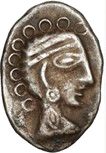

Stack’s Bowers & Ponterio N.Y.I.N.C.
8 January 2013 Lot # 269
The Axumites, contemporaries to the Romans who ruled ancient Ethiopia and parts of the Arabian Peninsula, produced gold, silver and bronze coinage on the same standard as the Romans, only in equivalent fractional denominations.
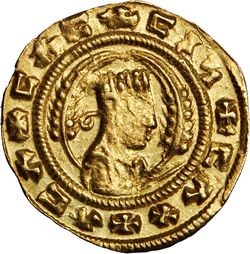
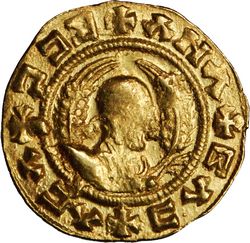
Aksumite Kingdom. Ebana. AV Unit (1.61 gms) ca. 440-470 A.D. Fr-8; Aksumite-34; Munro-Hay-71; BMC Axum-306.
(Stack’s Bowers & Ponterio NYINC auction, 10 January 2014, lot 94)
In Yemen’s western provinces of Sana’a and Thammar (Dhamar) mining has been active since the ancient Sabaeans were searching for gold, silver and other precious commodities. In the late 16th and early 17th century Yemen under the Ottoman Empire did produce their own coinage, but it consisted of tiny little silver coins weighing about half a gram each, predominantly only for local use. If mining was so active in this area why produce such small coins? Perhaps the Ottomans had other ideas that they wanted to use the money for. Or the distance between the mines and the major port cities of Aden and Mocha was just too great, being about 250 miles to Sana’a from either city or over 150 miles to Thammar. The author is unaware why larger coins were not produced.
Though no official large silver coins were issued during this period, this apparently did not hinder trade. As shown above, in times of need attempts to mitigate the pressures of commerce caused imitations to come to market. Now there is a difference between an imitation and a contemporary counterfeit, being that an imitation was made to circulate for commerce while a contemporary counterfeit was made to fool and cheat. The Spanish and Spanish colonial cobs contained in this group consisted of a varied gathering of 2, 4 and 8 Reales from Mexico, Bolivia and Spain struck at the Mexico City, Potosí, Granada, Segovia, Seville, Toledo and Valladolid mints. All are of either Philip II or Philip III no later than ca. 1615. When found they were totally encrusted and that is why many from this group exhibit signs of corrosion. The group was also accompanied by two strange looking 8 Reales that, as it turns out, are local imitations manufactured in the same process as legitimate Spanish pieces of eight.
The manufacturing of cobs is a fairly simple process where the metal needed to make the planchets was cut from a poured bar leaving sheared edges, where the planchets were cut from the bar, on opposing sides (i.e. 12 o’clock & 6 o’clock) as well as beveled edges, original edges from when the bar was poured, on the other opposing sides (i.e. 3 o’clock & 9 o’clock). After the planchets were cut they were struck by hand and this is the reason why so many are uneven, have misaligned or muled dies. The fact that the imitative cobs were manufactured in an identical fashion to legitimate pieces shows a higher level of sophistication not associated with contemporary counterfeits made to cheat some unsuspecting patron or merchant. Furthermore, the weights, purity, severe die deterioration of the “OMF” obverse die and linking of the reverse dies of these imitations are suggestive of prolonged use and that their intended purpose was to circulate alongside the then current specie.
This table summarises the coins found.
| Mint | 2 Reales | 4 Reales | 8 Reales | Total | |
| Phillip II | Mexico City | 1 | 7 | 8 | |
| Potosi | 3 | 3 | |||
| Granada | |||||
| Segovia | 1 | 1 | 2 | ||
| Seville | 1 | 4 | 5 | ||
| Toledo | 1 | 2 | 3 | ||
| Valladolid | |||||
| Sub-Total | 2 | 2 | 17 | 21 | |
| Phillip III | Mexico City | 1 | 2 | 3 | |
| Potosi | |||||
| Granada | 3 | 1 | 4 | ||
| Segovia | |||||
| Seville | 1 | 2 | 2 | 5 | |
| Toledo | 1 | 1 | |||
| Valladolid | 1 | 1 | |||
| Uncertain | 1 | 1 | |||
| Imitations | 2 | 2 | |||
| Sub-Total | 6 | 4 | 7 | 17 | |
| Total | 8 | 6 | 24 | 38 |
The Phillip II Mexico City mint coins are
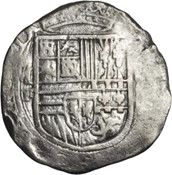
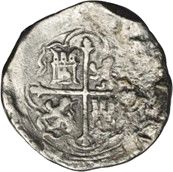
Figure 1.
8 Reales (26.18 gms), ND (ca.1556-98) Assayer F (oMF – 8) cf. Cal-Type 110 # 154; KM-43; Cayon-3914; cf. Calb-612; Grove-127; cf. Lopez-Chavez-Yriarte-Type I #478; Her-516. Obverse: (PHILIPPVS II DE)I (G)R(AT)IA
Reverse: (+HISPANIARVM ET IN)DI(ARVM REX)
Virtually complete shield with good definition of the details. Clear Assayer’s letter and mintmark, two Fleur de lis side by side. Virtually complete cross, clear lion and castle on left side. Beaded border on obverse, reverse appears to have a solid border.
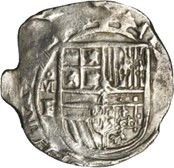
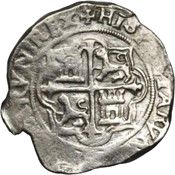
Figure 2. 8 Reales (27.23 gms), ND (ca. 1556-98) Assayer F (oMF – 8) cf. Cal-Type 110 # 154; KM-43; cf. Cayon-3914; cf. Calb- 611; Grove-132; cf. Lopez-Chavez-Yriarte-Type I # 478; Her-517. Obverse: P(HILIPPVS 8 II 8 )DEI GRA(TIA)
8 Reales (27.23 gms), ND (ca. 1556-98) Assayer F (oMF – 8) cf. Cal-Type 110 # 154; KM-43; cf. Cayon-3914; cf. Calb- 611; Grove-132; cf. Lopez-Chavez-Yriarte-Type I # 478; Her-517. Obverse: P(HILIPPVS 8 II 8 )DEI GRA(TIA)
Reverse: +HIS(PAN)IARVN( 8 ET 8 INDI)ARVN 8 REX
Broad flan with a bold complete shield, mintmark and assayer’s letter, Fleur de lis stacked one over two. Bold full cross, lions and one castle, much legend. Stops in legends “8”, “N” in place of “M” in “INDIARVM”. Beaded borders. There appears to be a shadow of a crescent atop the mintmark, but it is too degraded to verify.


Figure 3.
8 Reales (26.08 gms), ND (ca. 1556-98) Assayer F ( MF – 8) cf. Cal-Type 110 # 154; KM-43; cf. Cayon-3914; Calb-not listed; cf. Grove-132; cf. Lopez-Chavez-Yriarte-Type I # 478; cf. Her-517.
Obverse: (PHILIPPVS II DEI GRATIA) Reverse: (+HISPANIARVM) 8 ET 8 INDIARVN 8( REX)
Reverse: (+HISPANIARVM) 8 ET 8 INDIARVN 8( REX)
Bold full shield with clear mintmark, Assayer’s letter and denomination, Fleur de lis stacked one over two. Full cross and octolobe with decent lions and castles. Stops in legends “8”, “N” in place of “M” in “INDIARVM”.
Beaded borders.
The crescent atop the mintmark is quite an interesting feature. The existence of multiple dies and rotations clearly shows this characteristic was used for a prolonged period of time.
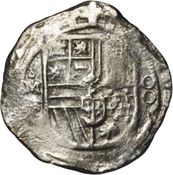
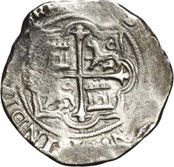
Figure 4.
 8 Reales (26.08 gms), ND (ca. 1556-98) Assayer F ( MF – 8) cf. Cal-Type 110 # 154; KM-43; cf. Cayon-3914; Calb-not listed; cf. Grove-132; cf. Lopez-Chavez-Yriarte-Type I # 478; cf. Her-517.
8 Reales (26.08 gms), ND (ca. 1556-98) Assayer F ( MF – 8) cf. Cal-Type 110 # 154; KM-43; cf. Cayon-3914; Calb-not listed; cf. Grove-132; cf. Lopez-Chavez-Yriarte-Type I # 478; cf. Her-517.
Obverse: (PHILIPPVS II DEI GRATIA)
Reverse: (+HISPANIARV)N : ET : INDI(ARVN :) RE(X)
Nearly complete shield with clear mint mark and denomination “8” as a composite number, Fleur de lis stacked one over two. Nearly complete cross with clear lion and castle on the right side. Stops in legends “:”.
Beaded borders. Shares same reverse side die as figure 5.
>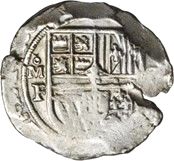
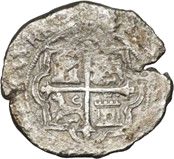
Figure 5.
8 Reales (26.08 gms), ND (ca. 1556-98), Assayer F ( MF – 8) cf. Cal-Type 110 # 154; KM-43; cf. Cayon-3914; Calb-not listed; cf. Grove-132; cf. Lopez-Chavez-Yriarte-Type I # 478; cf. Her-517.
Obverse: (PHILIPPVS II DEI G)RAT(IA)
Reverse: (+HISPANIARVM 8 ET 8 INDIARVN) 8 RE(X)
Bold partial shield with clear mintmark and Assayer’s letter, Fleur de lis stacked one over two. Nearly complete cross with clear lower lion and castle. Stops in legends “8”, “N” in place of “M” in “INDIARVM”.
Beaded border. Shares same reverse side die as figure 4.
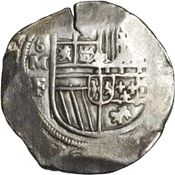
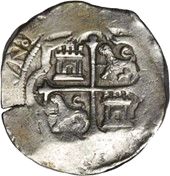
Figure 6.![]() 8 Reales (27.41 gms), ND (ca. 1556-98) Assayer F ( MF – 8) cf. Cal-Type 110 # 154; KM-43; cf. Cayon-3913/17; Calb- not listed; Grove-132; cf. Lopez-Chavez-Yriarte-Type I # 478; cf. Her-517.
8 Reales (27.41 gms), ND (ca. 1556-98) Assayer F ( MF – 8) cf. Cal-Type 110 # 154; KM-43; cf. Cayon-3913/17; Calb- not listed; Grove-132; cf. Lopez-Chavez-Yriarte-Type I # 478; cf. Her-517.
Obverse: (PHILIPPVS II )DE(I )GR(ATIA)
Reverse: (+HISPANIARVM 8 ET 8 INDIAR)VN 8 R(EX)
Bold partial shield with clear mintmark and Assayer’s letter, Fleur de lis stacked two over one. Nearly full cross with clear lions and castles, top two well executed. Stops in legends“8”,“N”in place of“M”in “INDIARVM”.
Beaded borders.


